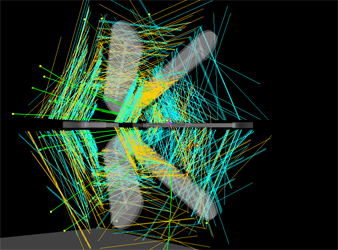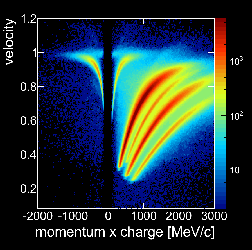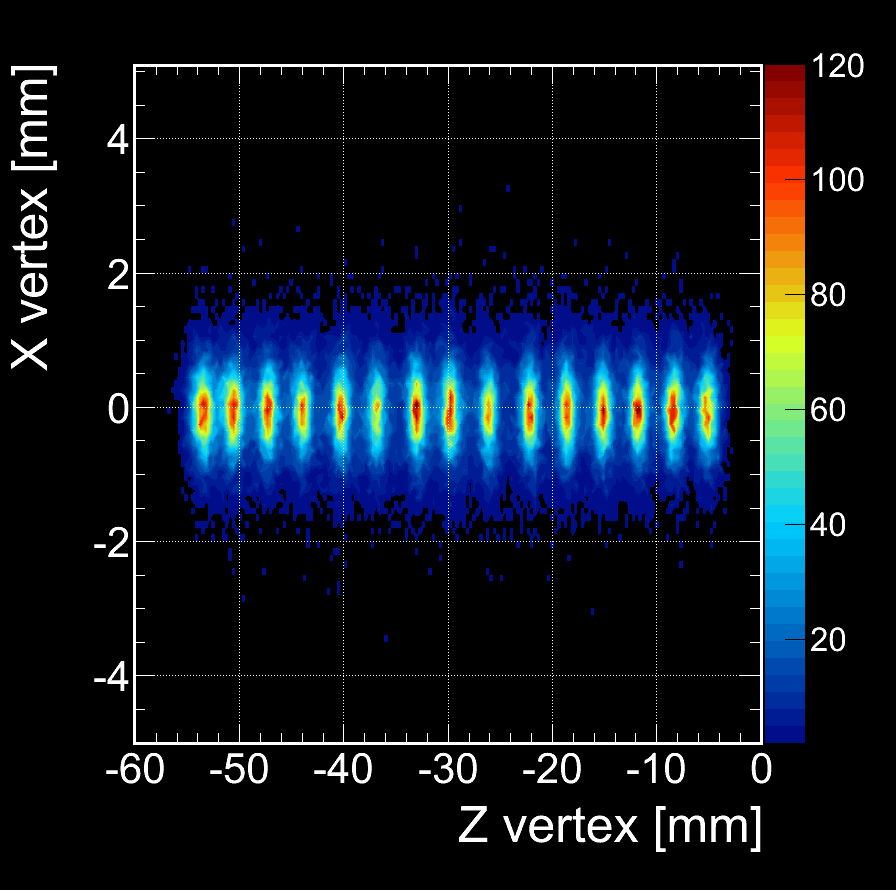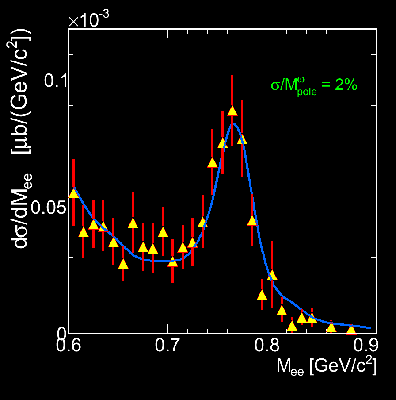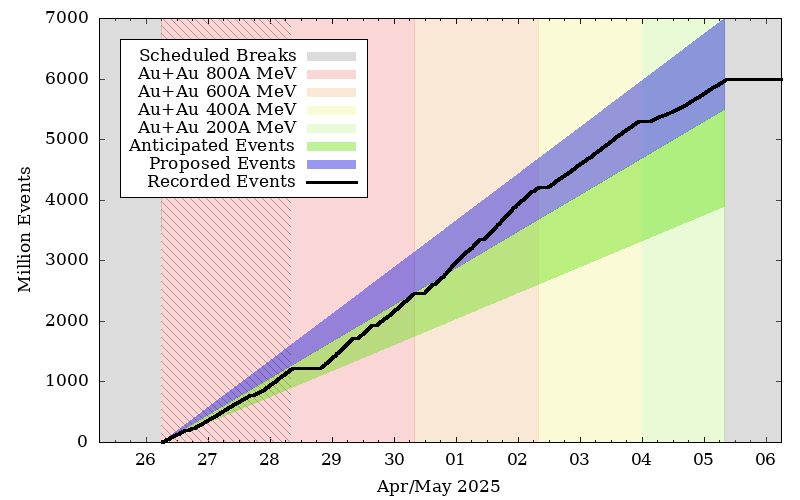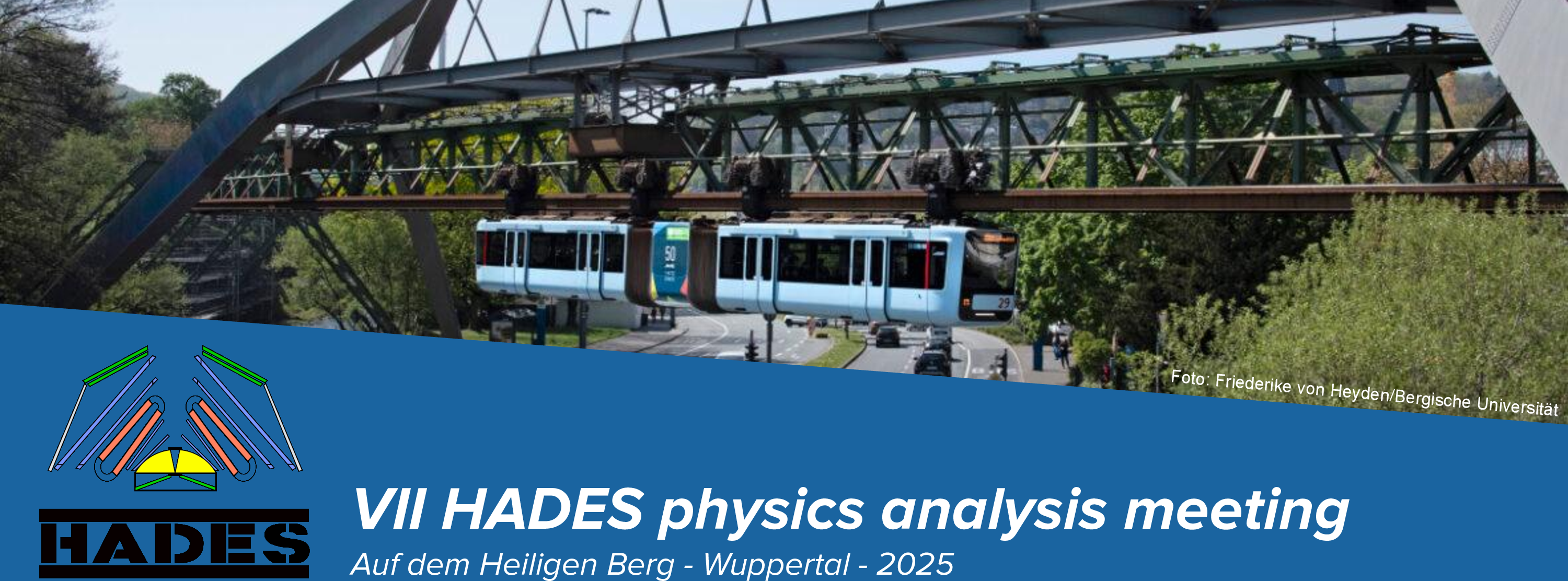Proposal for Experiments at the GSI Pion Beam Facility
White paper summarizing ideas for experiments with pion beam in the years 2026-2030.
The present proposal explores the dynamics of hadronic matter in the strong regime of Quantum Chromodynamics (QCD) through the use of the pion-beam facility at GSI in conjunction with HADES. The aim is to study hadron physics through elementary pion-nucleon interactions up to √s ≈2.35 GeV, thereby bridging research into cold matter with detailed analyses of exclusive reactions. The objectives of this programme are threefold: firstly, to explore the formation of baryon resonances and their electromagnetic structures up to the third resonance region; secondly, to complement photo-production experiments (e.g. ELSA); and thirdly, to enhance understanding of emissivity in dense, hot hadronic matter. Key topics include the study of baryon couplings to mesons and virtual photons, the analysis of hyperon weak decays in exclusive reactions, and the use of Partial Wave Analyses with differential cross sections and polarization observables to achieve unprecedented precision in baryon-meson coupling data (ρN, ωN).
Furthermore, e+e- production measurements of nucleons will provide insight into the electromagnetic transition form factors of baryons in the time-like region, revealing the role of vector mesons (ρ, ω). Reactions on nuclear targets allow for detailed studies of hadron properties, including vector-meson line shapes and strengths in cold nuclear matter. These measurements provide a critical reference between elementary π-nucleon interactions and the complex hot and dense environment in A + A collisions. The research also has broader implications, including contributions to the modelling of neutrino-nucleus interactions, facilitating unprecedented investigations into hypernuclei formation, and enhancing our understanding of strong interaction dynamics across different energy regimes.
Giersch Award 2024
 | 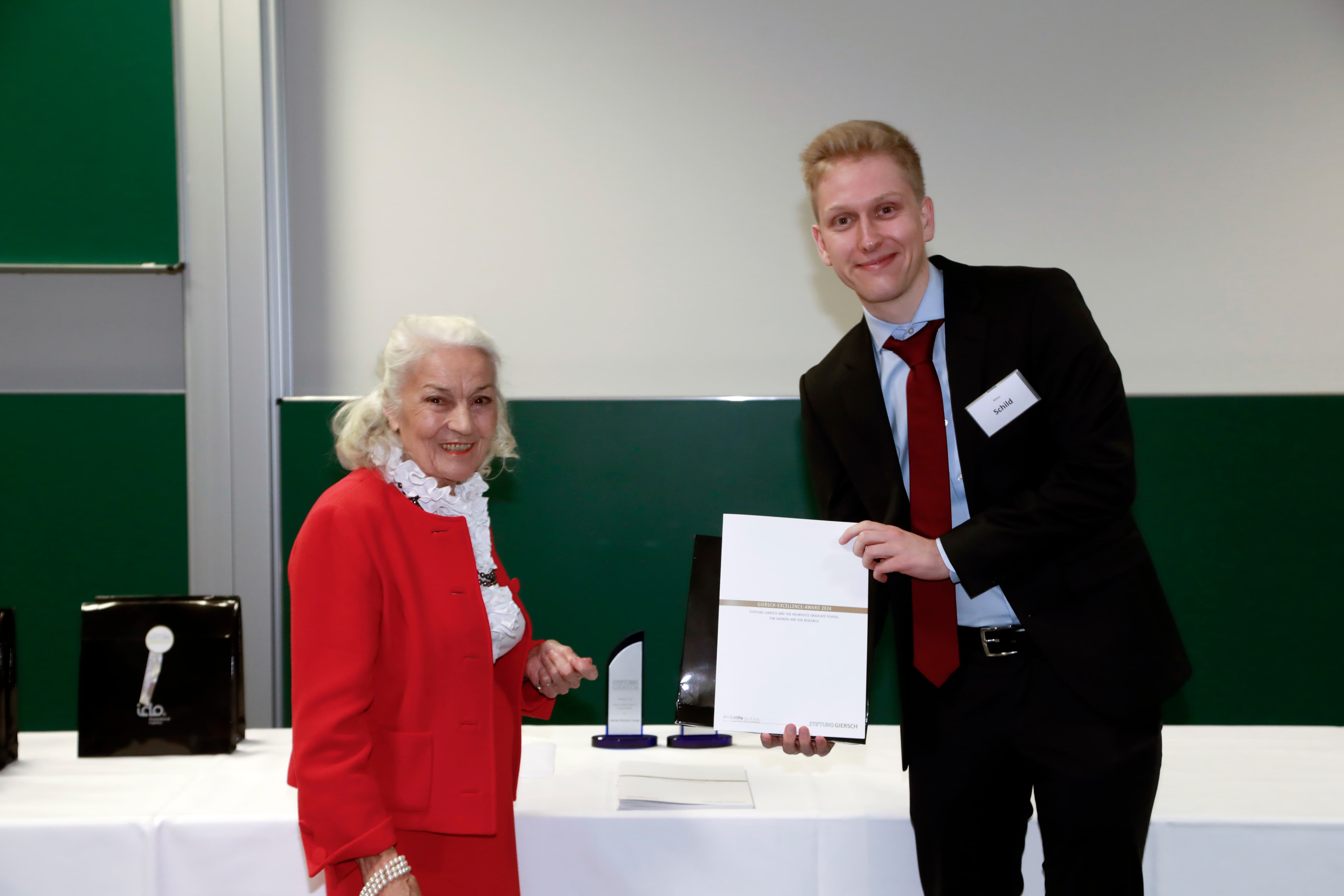 |  |
Iuliana-Carina Udrea and Niklas Schild have been awarded a "Giersch Excellence Grant" for outstanding scientific work in the thesis project in the past year. Congratulations to all Awardees.
Higher order flow harmonics of protons and light nuclei in Au+Au
A new paper with HADES data has appeared in Phys. Rev. Lett. It features flow coefficients (vn) of the orders n = 1–6 for protons, deuterons, and tritons as a function of centrality, transverse momentum, and rapidity in Au+Au collisions at 1.23 AGeV.
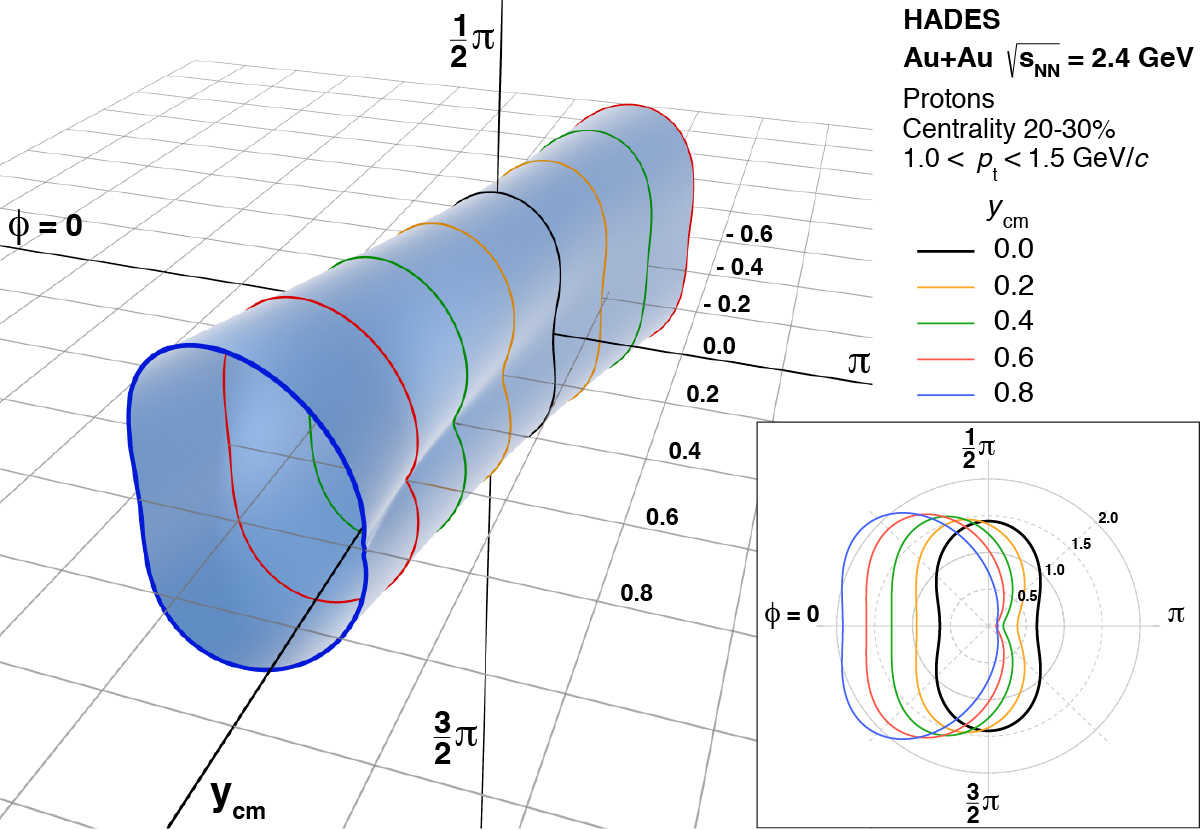
Combining the information from the flow coefficients of all orders allows us to construct for the first time, at collision energies of a few GeV, a multidifferential picture of the angular emission pattern of these particles. It reflects the complicated interplay between the effect of the central fireball pressure on the emission of particles and their subsequent interaction with spectator matter. The high precision information on higher order flow coefficients is a major step forward in constraining the equation of state of dense baryonic matter.
Phys.Rev.Lett. 125 (2021) 26, 262301
e-Print: 2005.12217 [nucl-ex]
New paper on proton number fluctuations
HADES has published new paper in PRC: "Proton-number fluctuations in sqrt(sNN) = 2.4 GeV Au+Au collisions studied with the High-Acceptance DiElectron Spectrometer (HADES)". Moments and cumulants up to 4th orders as a function of centrality and phase-space bins are presented.

The QCD critical endpoint (CEP) is a very distinct feature of the phase diagram of nuclear matter, but it can presently not be located from first-principle calculations; experimental observations are needed to constrain its position. The HADES Collaboration measured cumulants and correlators for net-proton number fluctuations, the most important observable so far to search for the CEP. This extends experimental results below the lowest beam energies available at th RHIC accelerator in Brookhaven (USA) and will be useful to discern the possibility of a critical point in the QCD phase diagram. These investigations will be continued in future experiments at FAIR.
Phys. Rev. C 102, 024914 (2020)
Probing dense baryon-rich matter with virtual photons
HADES reports on the measurement of the temperature T = 71 MeV inside the hot and dense fireball created in Au+Au collisions. Results have been published in Nature Physics.
About 10 μs after the Big Bang, the universe was filled—in addition to photons and leptons—with strong-interaction matter consisting of quarks and gluons, which transitioned to hadrons at temperatures close to kT = 150 MeV and densities several times higher than those found in nuclei. This quantum chromodynamics (QCD) matter can be created in the laboratory as a transient state by colliding heavy ions at relativistic energies. The different phases in which QCD matter may exist depend for example on temperature, pressure or baryochemical potential, and can be probed by studying the emission of electromagnetic radiation. Electron–positron pairs emerge from the decay of virtual photons, which immediately decouple from the strong interaction, and thus provide information about the properties of QCD matter at various stages. Here, we report the observation of virtual photon emission from baryon-rich QCD matter. The spectral distribution of the electron–positron pairs is nearly exponential, providing evidence for a source of temperature in excess of 70 MeV with constituents whose properties have been modified, thus reflecting peculiarities of strong-interaction QCD matter. Its bulk properties are similar to the dense matter formed in the final state of a neutron star merger, as apparent from recent multimessenger observations.
Nature Physics volume 15, pages 1040–1045 (2019)
HADES hunts Dark Matter
HADES has put an improved upper limit on the mixing of the photon with a hypothetical massive Dark Photon, the latter being the gauge boson mediating the interaction between Dark Matter particles.
Dark Matter in the Universe
The interpretation of current astrophysical observations results in the striking mass-energy budget of matter in the universe: ~75% Dark Energy, ~20% Dark Matter, and ~5% baryonic matter [1]. The latter number refers to stars and inter/intra-galactic gas, i.e. mainly free hydrogen. Dark Energy drives the presently observed accelerated expansion of the universe. It is homogeneously distributed and can be attributed to a cosmological constant or vacuum energy.
In extreme cases it may cause, in the future, such a sudden expansion that anything in the universe is disrupted – this would be the Big Rip. Dark Matter, in contrast, is bumpy and is needed to explain the formation of the ditribution of observed visible matter in the evolving universe, evidenced by the hierarchy of structures from (super)clusters of galaxies, galaxies, stars, planets and other compact objects such as meteorites, etc.
Many attempts have been made to pin down the nature of Dark Matter. Researchers believe that Dark Matter most likely comprised hitherto unknown particles which do not fit into the Standard Model of particle physics. The Standard Model is a theoretically sound quantum field theory with fundamental matter particles, such as quarks (bound in hadrons) and leptons (e.g. electrons and neutrinos), which interact via the exchange of force-carrier quanta, called gauge bosons (e.g., photons). Some of these species acquire their masses by the interaction with the Higgs boson. While evidence for the Higgs boson has been found recently at CERN (resulting in the 2013 Physics Nobel prize), the Standard Model looks now complete when supplemented by some neutrino masses. Indeed, nothing else seems to be needed to understand the wealth of atomic, subnuclear and particle physics phenomena – besides the remaining Dark Matter puzzle! This unsatisfactory state of affairs has therefore initiated worldwide efforts to search for Dark Matter candidates.
Among the list of candidates of Dark Matter is a hypothetical particle, often dubbed U boson or Dark Photon. These nicknames refer to the underlying theory construction: a second unitary (”U”) symmetry allows for quanta which are, in one respect, similar to photons – namely gauge bosons – but in another respect different from them: In fact, attributing to these quanta a mass makes them to Dark Photons having only a very weak interaction with normal matter. Through its mixing with the normal photon, the Dark Photon can also decay into detectable electron-positron pairs. One arrives hence at a scenario where any electromagnetic process involving ”ordinary” virtual photons might be affected by the Dark Photon visible as (small) deviations from the expected Standad Model behavior. In particular, the recently observed discrepancy of the muon magnetic moment anomaly gμ − 2 has been discussed as a possible sign of a Dark Photon.
The HADES Dark Photon search

Figure 1: The 90% CL upper limit on ε2 versus the U-boson mass obtained
from the combined analysis of HADES data (solid black curve).
We have searched for a narrow U -> e−e+ decay signal in dielectron spectra obtained with HADES in 3.5 GeV p+p and p+Nb reactions, as well as in the 1.756 GeV/u Ar+KCl reaction [2]. In contrast to previous experiments focussing on a specific decay channel, our analysis is based on the inclusive measurement of all e+e− pairs produced in a given mass range, i.e. from Dalitz decays of the π0, η, and Δ mostly. Using a maximum-likelihood method we have extracted an upper limit (UL) at a confidence level CL = 90%. With known detector efficiencies and decay branching fractions, this UL has then been transformed into an UL on the mixing parameter ε2 as shown in Fig. 1 together with limits from the searches conducted by BaBar, KLOE-2, APEX, WASA at COSY, and A1 at MAMI. In particular at low masses (MU < 0.1 GeV/c2) we have improved on the recent result obtained by WASA, excluding now to a large degree the parameter range allowed by the muon g − 2 anomaly. At higher masses, the sensitivity of our search is compatible with, albeit somewhat lower than the KLOE-2 analysis of Φ decays.
References
[1] J. Behringer et al.. (Particle Data Group), Phys. Rev. D 86 (2012) 010001.
[2] G. Agakishiev et al. Phys. Lett. B 731 (2014) 265.

